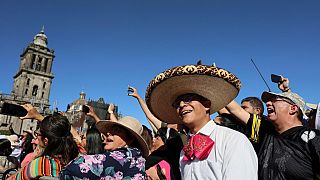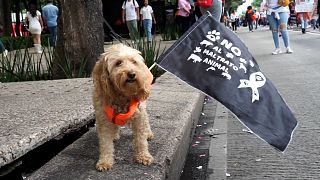Mexico
All that remains of the colourful signs marking the street food stands in Mexico City are silhouettes, replaced by a bland government sign.
The mayor of Cuauhtemoc municipality, which includes the old town and the traditional neighbourhoods of Condesa, Roma and Juarez, has ordered the removal of the signs that adorned hundreds of food stalls.
But a citizens' collective has rejected the mayor's decision, arguing that the tin stands and their signs are "part of the city's identity".
The signs and drawings advertising "Nutrijugos Dax", its competitor "Súper Jugos Curativos", "Supertortas la Sabrosita" or the colourful red letters of "Ricos Tacos de Guisado" have given way to the anodyne phrase "Alcaldía Cuauhtémoc es tu casa" (Cuauhtémoc Mayor's Office is your home).
It is a question of "order, discipline" to "improve the urban image", says mayor Sandra Cuevas, who snatched the post from the leftist ruling party in the 2021 elections.
It seems a minor matter in a city of nine million people afflicted by heavy traffic, pollution and earthquake risk.
But the tin stalls, where thousands throng to eat, and their signs are part of the city's DNA.
"It's an attack on the identity of the city and of all Chilangos," says art historian, Aldo Solano.
"They erased many signs that are popular art, part of the traditional image" of the city, he rebukes.
The signs themselves are the menu of the street food stalls, which number in the thousands in the capital and offer an infinite number of preparations.
A picture of steaming tacos or a smiling pig in a pot leaves no doubt that you can enjoy the famous Mexican dish or pork "carnitas" fried in lard.
The origin of these illustrations goes back to the beginning of the 20th century when illiteracy rates were high in Mexico. "That's why an iconography was used. This is not the case now, but this tradition is preserved," explains Solano.
Since then, sign-makers and food vendors have been pursuing the same goal: to get noticed, easily and quickly, in a crowded public space.
But now, with the stalls unified by an official sign, it will be more difficult to know what each one is selling.
"It's a basic marketing tool," says Tamara de Anda, a member of a group that is building a digital archive of the city's signs with input from citizens.
Fearing reprisals, the vendors are reluctant to protest.
"They told us 'you take it down or you take it down," says the clerk at a juice stand, speaking on condition of anonymity.
Since 1985, Adán Navarrete has painted numerous businesses with drawings such as a chef showing off a dish or a smiling clown for a children's party shop.
But his business began to decline with the adoption of new painting techniques in the 1990s, and now he's taking another hit with Cuevas' ordinance, which some call a "mayoral slap on the wrist".
"Taxis, cargo vans, curtains (of businesses)," recalls Navarrete, who laments that while "technology keeps going up", his trade "is going down".
He describes Cuevas' policy as a "very big mistake". "As simple as it may seem, and it may seem ugly to them, but it is an art," he says.
Sadly, he acknowledges that several of these creations, which were periodically retouched, are lost forever. "It's very difficult to do it again because many masters no longer exist.













01:00
Chidimma Adetshina crowned Miss Universe Africa and Oceania
02:20
Detroit-based East African restaurant finalist for top US restaurateur award
01:00
Total solar eclipse viewed by tens of millions in North America
Go to video
Podcast| Are edible insects the food of the future?
Go to video
Combatting biopiracy: Ethiopian entrepreneur revives teff farming for ancestral heritage
Go to video
Fati Niang, the chef who is decolonizing Senegalese street food